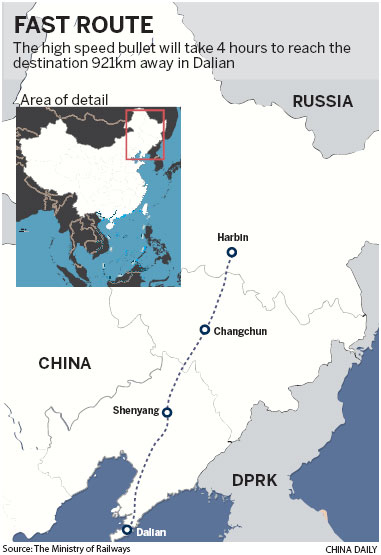
A new high-speed railway linking China's major northeastern cities of Harbin and Dalian will begin operation on Saturday, with experts predicting the 98 billion yuan ($15.7 billion) infrastructure investment could accelerate social and economic cooperation right across northeast Asia.
The 921 km route, with 24 stops, is the world's first high-speed, high-altitude rail line, and has been designed to withstand extreme temperatures, according to the Shenyang Railway Bureau.
|
 |
The high-speed link is expected to reduce the travel time between Harbin and Dalian to four hours, from the current 10 hours.
The CRH380B bullet trains serving the line can operate in temperatures as low as -40 C, and as high as 40 C.
Local officials and experts said they expect the railway to not only make travel easier, but also provide a huge economic boost to the region.
The northeastern provinces (Heilongjiang, Jilin and Liaoning) are considered some of China's key industrial bases, and the high-speed rail line is expected to ease transportation bottlenecks, said Zhu Shu, a senior official with the United Nations Development Program's Tumen project.
|
 |
In the late 19th century, northeastern China's prosperity was highly reliant on railway construction.
Today the region plays an important role in providing food and energy resources to the rest of the country, and is an important trade link between China, Russia and the Korean Peninsula.
The border between Heilongjiang province and Russia is more than 2,000 km long.
According to local government figures, the volume of trade between the province and Russia reached $18.99 billion in 2011, representing nearly a quarter of the country's total trade volume with its northern neighbor.
Liaoning and Jilin also play an important role in economic cooperation with the Korean Peninsula.
There are over 4,500 South Korean enterprises in Northeast China with investments by companies, including STX, LG, SK, POSCO and Hana Bank worth $4.58 billion.
Dandong, in Liaoning province, meanwhile, sits on the main route for trade between China and the Democratic People's Republic of Korea.
In 2011, the city's import and export trade with the DPRK was worth $1.86 billion, accounting for 40 percent of Sino-DPRK trade volume.
In the past three years, China has launched many policies to promote the opening-up of Northeast China, most recently in early August when the State Council approved a plan to push cooperation between the region and Russia.
The three provinces have also worked hard to enhance cooperation with countries in northeast Asia.
"It's very important and viable for China to strengthen its cooperation with Russia," said Qi Wenhai, researcher of Northeast Asian Studies Center at Heilongjiang University.
However, he added one of the main stumbling blocks has been transportation infrastructure.
Da Zhigang, director of Northeast Asia Institute at Heilongjiang Provincial Academy of Social Sciences, said that the new high-speed railway will help accelerate passenger, logistics and information flow, which will directly or indirectly promote contact between northeast regions and neighboring countries.
He explained that the four core cities along the railway - Harbin, Changchun, Shenyang and Dalian - are linked closely with future economic exchange.
Besides the new high-speed railway, the three provinces are also planning to build a local high-speed railway network, including lines from Shenyang to Dandong, Changchun to Hunchun, and Harbin to Fuyuan, all of which will have terminals very close to Russia and the DPRK.
Experts agreed that the new railway lines represented an important import and export channel for China, which will ease current freight transportation pressures, and mean that bulk goods, such as coal, oil, wood and grain, will be transported to southern regions far quicker.
Lin Zhonghong, deputy director of the Economic and Planning Research Institute of the Ministry of Railways, was quoted by Xinhua News Agency as saying the high-speed railway will increase the transport capacity between Harbin and Dalian from 50 million to 60 million metric tons a year.
Contact the writers at wuyong@chinadaily.com.cn and liuce@chinadaily.com.cn
Han Junhong in Changchun and Zhou Huiying in Harbin contributed to this story.
Related readings:
High-speed trains to traverse frigid regions
China's operating high-speed rail exceeds 7,000 km
China's cold-proof trains to withstand temperature changes
Northeast to benefit from new high-speed rail link
Related pictures:
Crew ready for Harbin-Dalian high-speed rail
China tests world's 1st alpine high-speed rail line







